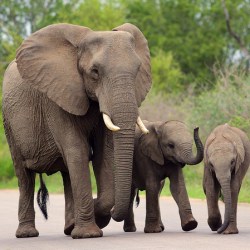We Are Losing The War For Elephant Conservation

Over the past seven years, according to a survey conducted in 2016, nearly one in three African elephants has disappeared. That means there are less than 400,000 elephants left and conservationists say that if the poaching is not stopped it is very probable that the species will become extinct across several African countries in the coming decade. It is notoriously difficult to get accurate elephant population statistics because the most recent census took place two years ago. Nevertheless, African elephants are still considered a vulnerable species according to the International Union for Conservation of Nature.
90 per cent of the population exterminated
WWF estimates there are approximately 415,000 wild African elephants and whilst that number is higher than the last census, the prognosis is still not good with more than 90 per cent of the population having been exterminated in the last century. According to WWF approximately 20,000 African elephants are poached for their ivory which is an average of 55 every day. Over the last dozen years, elephant populations have been wiped out in several African countries.
Some conservation efforts have been successful
It’s not all bad news though, countries such have Kenya have put in a lot of hard work and effort in order to stop poaching and stabilise their elephant populations. Their success has been double edged however because there is increasing conflict between humans and elephants so a lot of effort is being spent on trying to prevent elephants from travelling to areas populated by humans.
Different dynamic in Asia
In Asia the situation is worse with only 40,000 to 50,000 wild Asian elephants left. The population has fallen by more than half over the last three generations though for different reasons to those that drove the population down in Africa. In Asia the level of poaching is far lower than Africa and when elephants are killed in Asia it is usually as a result of human elephant conflict. Humans encroach in the habitat of elephants and the disappearing habitat has meant that elephant populations are spread out over smaller areas.
Technology is being deployed for conservation
WWF has some terrifying statistics and claims that more African elephants are being poached than born and argues the species is facing the worst crisis in conservation since the ban on ivory was first imposed in 1989. The organisation has begun to tag and track both elephants and rhinos with GPS technology which will allow rangers to monitor and protect them. Google has given money to establish a special Wildlife Crime Technology Project which uses drones for surveillance. Thermal imaging cameras have also been placed at waterholes and other places with poachers may try and hunt elephants and rhinos.



